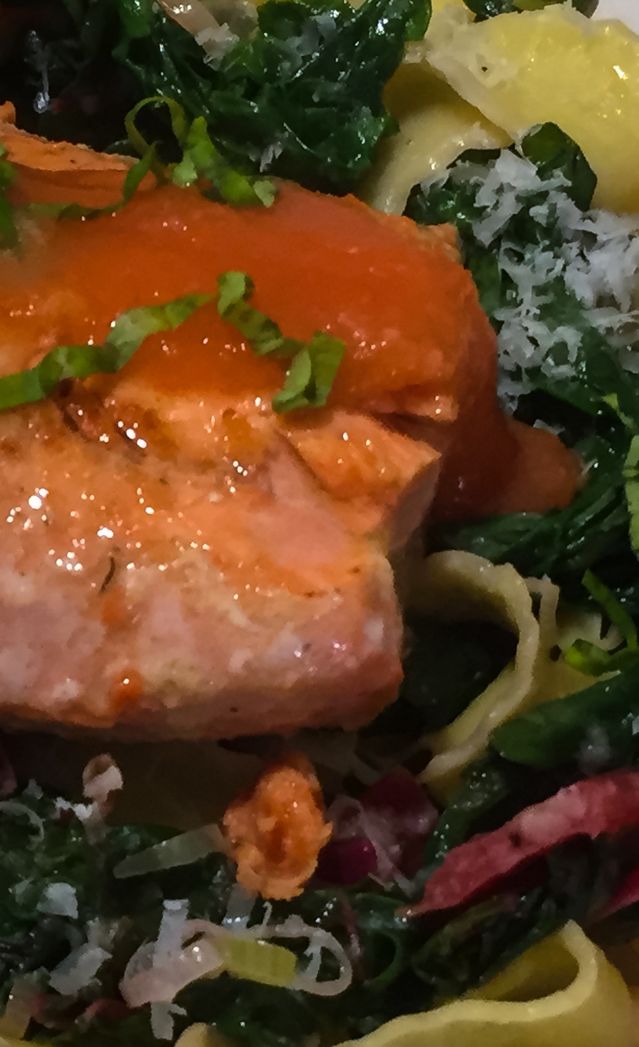As I journey from place to place across this country (and even across the globe), it quickly becomes apparent that one of the great challenges to a proper food experience is travel and time. In my forthcoming book, Food Shaman: The Art of Quantum Food, I extensively discuss one of the keys to success, which is how to source like a chef.

However, few things strike at the heart of the matter, or are more illustrative, than the call; “Physician, heal thyself!” With that in mind, I will share a recent experience which from a chef’s perspective was more like an episode of “Neutered” than Chopped. Like most things, the recipe for achieving success is about proper mis en place, time management, and execution.
Step One: Recon
Know where you’re going and how long you’re going to be there. It sounds like the completely straightforward advice offered on every other Facebook meme, from self-proclaimed “life coaches”, or Capt. Obvious. But so very often when we head out to a new destination, at least with respect to what we’re going to eat, it seems like we are still using the travel guidelines of Columbus. The first thing I do is look at the length of the trip and the number of destinations.
A very short trip of just a few days or a longer trip with a great number of various harbors along the way calls for a different approach than a longer stay in one, or just a few locations. Researching ahead of time can reveal to you the available eateries. If you happen to know folks from the region, you can always ask them about the best options for dining out. This is when it is a great advantage to have a chef friend in the city.
Many localities now sport various venues that offers some combination of fresh, local, and/or organic products. Touching base with someone at the hotel with a phone call or email can also be quite revealing. Alas for me, my most recent excursion was a singular terminus of several days duration with nothing but fast food offerings in the immediate vicinity. In these types of situations, my first solution is to look for hotels that offer complimentary kitchens.
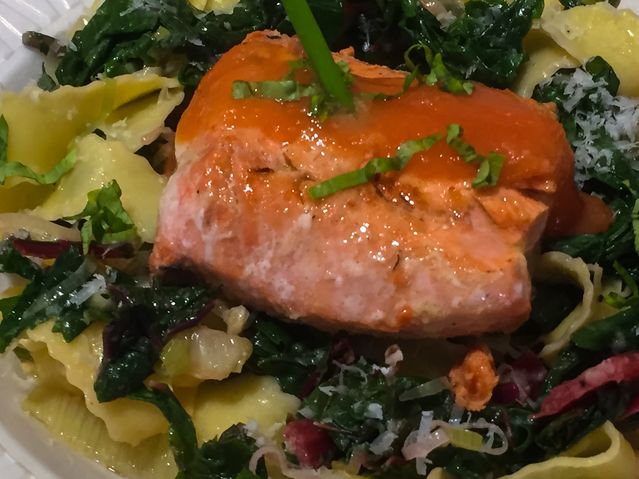
These chains like a Marriott Residence Inn, or a Staybridge Suites, often have accommodations that include a full-size refrigerator with freezer, range top, an assortment of basic cooking utensils, and sometimes even an oven. To complement this, I may need only to pack a trusty cutting board and my chef’s knife. Unfortunately, such an easy solution was not to be had on this excursion.
Confined to working within the realms of reality, I looked for the next best thing. Among the many hotel options available in Anytown, USA; a hotel room with a mini fridge – often with a few other amenities – is almost always available. Such were the choices where I was headed. The good thing about such lodgings is they often provide some sort of dining; at a minimum, there is usually a complimentary breakfast. This means that plates, bowls, napkins, eating utensils, and often some basic usable items like salt and pepper are readily available for you to squirrel back into your room like an escapee from an episode of Hoarders.
This, however, did leave me with limited preparatory options. The answer was to pack a small container that could provide a workable, portable kitchen (I do end up using the catering portion of my culinary degree more than I care to admit!). This entailed spending a few extra minutes when stuffing my luggage to also pack up a convection hotplate, a cutting board, my chef’s knife, and a few other small kitchen essentials into a travel box in addition to one pot and one pan. All told, it took only about 15 minutes of additional packing time. With minimal muss and fuss it was checked with my other luggage at arrival to the airport. Knowing what I had and what I needed to bring left me with a secure base of operations and ready to move onto the next phase.
Step Two: Supply Lines
Knowing ahead of time what you’re cooking options are, is a great organizational timesaver. It also allows you to focus in on those items that can be quickly and easily prepared with the resources at hand.
But what are those items?
A quick bit of inquiry utilizing the Internet or driving app programs on your cell phone can give you an idea of what sort of grocery shopping is nearby. It is also often worth inquiring, particularly easy to do at check in, about any local farmers’ markets or equivalent that you may be able to visit.
Less than 15 minutes of Internet surfing while on my flight revealed both a local farmers’ market and grocery stores that carried fresh, local, and organic produce and product. The latter was most important if my schedule did not permit time to explore the items at the farmers’ market; or as I have discovered on some occasions that such a scene contains neither farmers nor any kind of food market. The stores that offer the ability to select items in bulk are a great boon for road warrior chefs. Here you can purchase small quantities that are perfect to use up during the course of your stay with little to no waste. Likewise, stores with extended hours can accommodate odd hour shopping needs for those of us who find ourselves in such predicaments.

The fact that I had no freezer meant that all the purchases had to be stored at either room temperature or refrigerated. Given that these Gimli sized units are notoriously sparse on space, that up put a premium and a limitation on purchasing those items that had to be kept cool. Thus depending on the length of your stay, it may require one or more additional trips to the market.
By utilizing a couple of different outlets, I was able to secure a combination of fresh, local, and organic products. There were local peaches in season as well as several varieties of locally grown vegetables and fresh herbs. There was a regional supplier of free range, pastured, organic eggs and amongst the previously frozen imported-from-who-knows-where seafood were some fresh, wild Alaskan sockeye salmon fillets. Adequately provisioned, I could smell victory.
Step Three: Rules of Engagement
All of this effort is for naught if we can’t produce delicious food. And for all the apparent hardship, as The Bard wrote in Hamlet centuries ago; “There is nothing either good or bad, but thinking makes it so.” For as we strive to attain both nutritious and delicious all the while stripped of much of our modern technology and convenience, we are driven by necessity to approach food more simply. This translates into a deeper eye for details of taste and texture; and a much greater appreciation of the food experience that accompanies such a meal.
Being on the road and away from friends and family for long stretches makes us appreciate how tender is the time that we have together. And when I can craft such meals, they help sustain me physically through the privations of work and travel; but they also serve a higher purpose. They bring me closer to life’s important elements. The sorrow of absence gives way to the joy of future reunion and ultimately to the acknowledgment of greatest gratitude for the people and places missing from my table.
Ultimately what you can afford to prepare depends not only on your budget, but also on your available time. As any chef worth their salt will tell you, it’s all in the prep. For example, the flatbreads describe the sample recipes that follows may seem like an impossibility. However, for me, it took about 15 minutes to mix up the dough in the morning while I was mentally reviewing the tasks to follow at work later. I put the dough in the refrigerator covered in the plastic bag used to sack the groceries. Refrigeration doesn’t stop the proving process, but it slows it down.
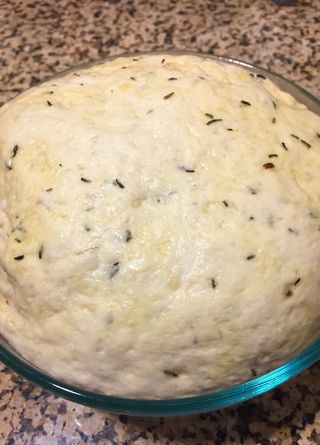
That evening when I returned from the day’s activities, it was a simple matter to shape the breads and stuff them. The potatoes boiled while I showered, a few minutes to assemble the veg and mustard dressing while the flatbreads cooked and dinner was ready. I enjoyed both delicious and nutritious, salubrious and scrumptious, all in the comfort of my hotel room at significantly less time and expense than it would’ve taken me to clean up, drive, order, wait, and return from someplace offering far less pleasing fare.
Victory or Death!
The major changes to our food and food pathways which have occurred since the end of World War II have yielded, not surprisingly, both banes and boons. While we have reaped much, chief among them convenience; we have also sacrificed our independence of choice and to a degree our self-determination. Without question, the easiest solution is to visit some of the many great chefs preparing fresh, wholesome, and authentic foods wherever you might be. There is no doubt that an endeavor such as the one I have outlined requires effort and work.
Yet for those of us that spend significant portions of our lives on the go, the dietary choices that we make on the road are quite literally matters of life and death. Our food style reflects our lifestyle and as Metallica wryly (and Frantic-ally) observed, “My lifestyle determines my deathstyle.” Authenticity often requires sacrifice, work, and effort; but in return it brings its own rewards.
The modern world offers many easy paths. Many of them, we are learning, like the modern Western diet, are less roads to salvation than blind alleys. When it comes to our diet and our health we must weigh the decision like a physician; risks versus rewards, boons versus benefits, convenience versus consequence. For those of us that live to eat, and love to eat a lot (thus requiring that we also eat to live); it is really no choice at all.
Sample recipes:
Sesame Thyme Flatbread with optional Caramelized Onion, Mushroom, and Cheddar Stuffing Recipe (adapted from Paul Hollywood’s basic flatbread dough recipe in How to Bake by Paul Hollywood; Bloomsbury Publishing, 2012)
Why this works: the simple stuffed flatbread has likely been a human staple since the first breads were cooked in embers at least 10,000 years ago. In other words, they’re not complicated. The dough only takes about 15 minutes to put together in the morning and the final preparation can be finished in about the same amount of time after the day’s work is done. By making several at once, the extras can be stored in the refrigerator for several days. This makes for instant leftovers far better than anything you could scrape out of the take-away box. As satisfying an accompaniment to the warm potato salad with mustard dressing that I initially served them with; they’re equally delicious served with a fried egg (runny yolk a requirement) or omelette and side salad.
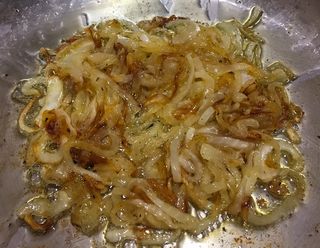
Ingredients:
- 500g (18 ounces, ~ 2 ¼ cups) flour
- 2 tsp. salt
- 1 Tbsp. yeast (2 pkg rapid rise yeast)
- ~ 8 ounces water
- 1 Tbsp. sesame seed
- 1 ounce (2 Tbsp.) melted butter
- 1.5 Tbsp. dried thyme
Directions:
Mix the flour, salt, and yeast together in a bowl. Add the butter, dried thyme, and sesame seeds and mix again. Add approximately two-thirds of the water, and using your hands mix the dough together. Slowly add the remaining water, until the dough comes together. Depending on the flour and relative humidity you may need slightly more or slightly less water. Once the dough has come together, knead for about five minutes, cover and allow it to prove for at least 1 to 2 hours, or when it has doubled in size.
Punch the dough down and divide the dough into six equal portions and shape into balls. If you’re going to stuff the flatbreads, proceed to the directions below. If you are just going to grill the plain flatbreads, then shape them out into 6 to 8-inch disks. Allow to rest at least 15 to 20 minutes. Add some oil to a pan over medium heat. Cook each flatbread 2 to 3 minutes on each side, until golden brown. Serve immediately.
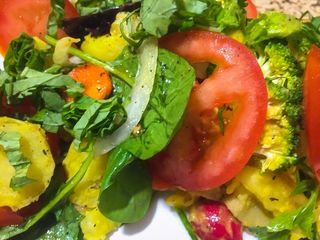
Optional stuffing:
Ingredients:
- ½ medium yellow onion, sliced thinly
- 6 ounces mushrooms, sliced thinly
- 1 tablespoon olive oil
- 1 tablespoon butter
- 2 ounces cheddar cheese, shredded or sliced thinly
Directions:
Heat the olive oil and butter together in a pan over medium low heat. When the butter has stopped bubbling, add the onions and allow to cook until lightly browned and caramelized. Add the mushrooms and continue to cook until the mushrooms are thoroughly done and the mixture has reduced by half to two-thirds. Remove from the heat and set aside.
Divide the mushroom onion mixture into six equal portions, divide the shredded cheese equally amongst them. Using your thumb, push a depression into the center of each dough ball. Spoon in a portion of the mushroom onion and cheese mixture into each depression and reseal the balls. Gently flatten each ball into a disk and allow to rest at least 15 to 20 minutes. Prepare the flatbreads as described above.
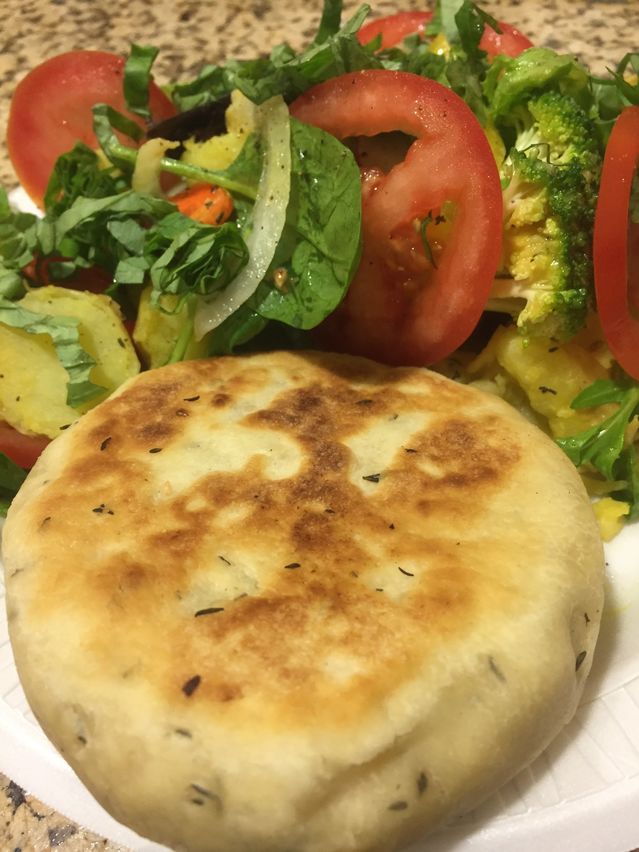
Citrus, Ginger & Peach Pan Seared Salmon
Why this works: this is a classic example of using what you got. The local peaches offered tremendous flavor (and they were on the cheap), and without added sugars the sauce is none too sweet. The ginger not only adds flavor, but a background heat that is a lovely changeup from omnipresent sriracha and chili sauce at every restaurant. The citrus adds acidity and together with the herbal notes of the basil forms a lovely complement to the simple pan seared, and fatty (healthy omega-3) rich salmon. The remaining sauce has a multitude of other uses including dressings and is a lovely topping for yogurt or kefir served with granola and fresh fruit to start the morning.
Citrus, Ginger & Peach Sauce:
Ingredients:
- 3 peaches, pitted and roughly chopped
- Nob of ginger, peeled and roughly chopped, approximately 1 tablespoon
- Juice of 1 lemon
- Juice of 1 lime
- 1 tsp. salt
- ½ tsp. black pepper
- Basil, thinly sliced for garnish
Directions:
Place all the ingredients together into a pot to which has been added a little water; just enough to keep the peaches from scorching until they begin to soften and release their juices. Place over low-medium heat. Once the peaches have softened, smash the ingredients together and reduce until thickened. Remove and reserve.
Salmon Marinade:
Ingredients:
- Peelings from ginger
- Juice of 1 lemon
- 1 garlic clove, crushed
- 1 tsp. mustard
- 1 tsp. salt
- ½ tsp. black pepper
- 3 Tbsp. olive oil
- 1 tsp. dried thyme
- 1 tsp. mustard
Directions:
Add all the ingredients to a bowl and mix. Add salmon filets and allow to marinate for several hours. To cook, place in a pan over medium-high heat to which oil has been added. Cook to desired doneness, remove, and top with sauce. Garnish with freshly chopped basil and serve immediately.
